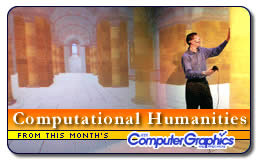|
| creative-vision.org | portfolio | |
virtual environments |


“Early in the eighteenth century, [Gotfried Wilhelm] Leibniz envisioned what might fairly be called the first reality engine. Central to the argument of the Theodicy (1710), is the claim that the mind of God comprehends an infinity of possible worlds, each of which exists in potentia. Of these, only one was brought into being, because only one – the actual world in which we live – fulfils the divine plan for creation. [Keep93]”
And so it is that we transition to the 21st century; wherein, we stand at the edge of a realm equipped to empower each to envision worlds of their own. Make no mistake, these “made worlds”, and our vision do not compare with the grander of our physical existence. They do, nevertheless, provide us a vehicle of exploration: Exploration of physical and emotional experience.
In the words of Howard Rheingold: “The computer will change the way we create and express ourselves, whether the form of expression is writing, music, painting, sculpture, or virtual reality. The computer will change the way we think about writing, music, painting, sculpture, and reality. With computers as partners, new worlds of expression will unfold. [Rheingold92]"










copyright (c) 2003 timothy griepp, all rights reserved
email: tim_griepp_webmail@creative-vision.org